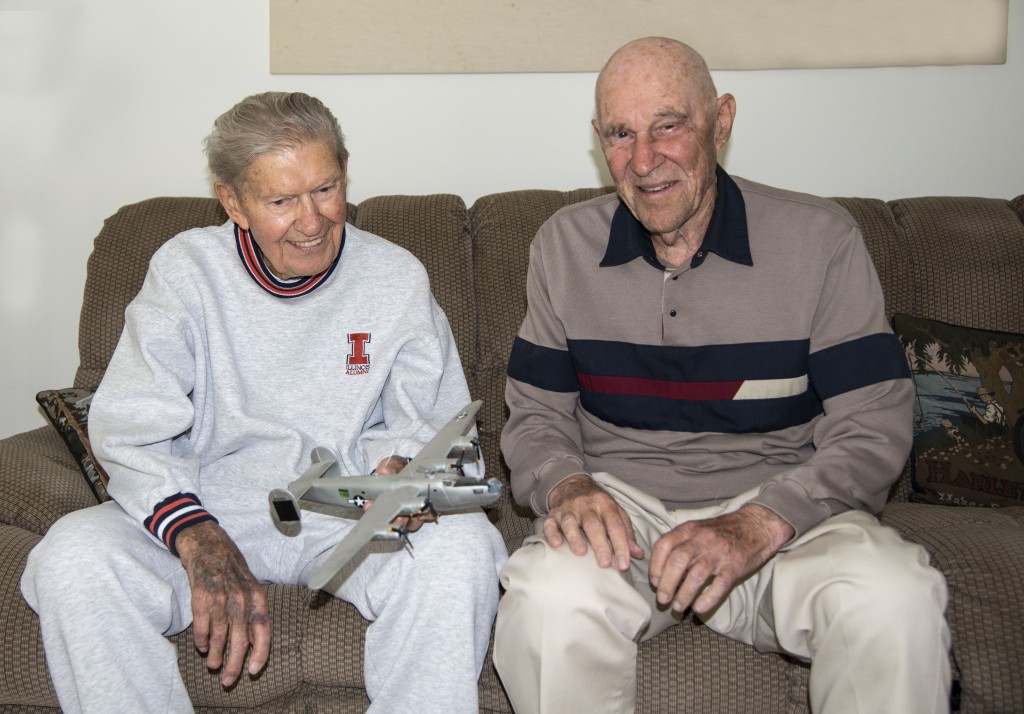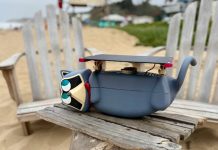
In honor of the anniversary of the attack on Pearl Harbor, the Indy pays tribute to two noteworthy Newport Beach WWII veterans.
•— Charles Weinberg contributed to this story.
One Newport Beach neighborhood, two Air Force veterans, a few bomber planes and endless stories about very different military experiences.
First Lieutenant Sheldon “Shelly” Ross, 92, and Col. Mike Piatnitza, 93, both retired, live in the Harbor View Hills South community and shared a lunch recently to talk about their experiences in the Air Force.
The two men flew on similar planes, but for very different reasons.
Ross, who was in the Seventh Army Air Force, flew in B-25 planes and bombed targets in a B-24 Liberator.
Piatnitza flew the B-17s, B-24s, and others, while testing equipment he modified, and worked on improvement projects for a number of planes, including the B-25 and C-47. He also flew in other planes on military intelligence related missions.
While Piatnitza may have been testing equipment or transporting a high ranking military official or information, Ross was bombing Iwo Jima and securing locations.
Both started active service in 1941, but under very different circumstances.
Ross went in with several friends in October 1941 to serve their one year, he explained. He wanted to go in, get his one year of service over and done with, and move on with his life.
A few short months later the U.S. entered the war.
“When the war broke out, I had been in the service for two whole months,” he said.
Piatnitza, on the other hand, had long term plans for military service.
The career military man started in the service in ROTC at the University of Illinois in 1936 while he was studying to become a chemical engineer.
“I changed after the first year because I didn’t like inhaling the smoke,” and “glass blowing up,“ which happened sometimes in chemistry, Piatnitza explained. So he finished in civil engineering.
At the end of the term in 1941, he started active duty in the Armored Force in July.
Both went into training immediately.
Piatnitza went to Fort Knox for six months to learn how to “take guns apart, put them together in the dark, and fix big guns and pistols,” he explained.
Training school provided some interesting stories.
During this time Piatnitza wrecked three tanks.
“They bragged about the tank being so formidable it could mow down trees. Well, I tried it,” Piatnitza said. “I found it’s not true.”
One tank he was in charged across a field in a training exercise. They encountered a large stone fence and had to either go around or over. Piatnitza took one look at the driver, a truck driver from New York, and they knew what they had to do.
“He aimed it and hit this fence, boom, full speed,” he said. “We flew over the damn thing when it hit. We just took off. We landed on the biggest rock in (the field).”
Another tank bit the dust when Piatnitza went down a long hill and onto a pond that had been frozen over but recently thawed out.
“I said, ‘Folks, I think we gotta get out of here because pretty soon we’re going to be underwater,’” he said. “I don’t know what happened to it. I left it there. I got my troops out and went the other way, toward dry land.”
After training, both men quickly applied to the Air Force.
“I just wanted to get out of the infantry,” Ross said, who had been sent overseas.
He passed the tests and was accepted as a bombardier.
“Everybody wanted to be a pilot, but my aptitude test turned out to be a bombardier,” he said. “That’s what the Air Force figured out (about me).”
“We (bombardiers) had the best view you could have,” Ross continued. “Front of the plane, all glass around you, and a beautiful view.”
Ross, originally from Cleveland, went to cadet school in Santa Ana Army Air Base. He went to bombardier school in Roswell, N.M., and navigation school in Carlsbad, N.M.
After going to planning and tactic school, Piatnitza applied to the Air Force.
Everybody went to an operational base to learn how to operate an airplane in war time, “shoot guns, find enemies, things like that,” Piatnitza explained. But he, instead, went to Wright Field in Ohio and was assigned to research and development.
After all the training was all done with the two men went on to work in their respective fields, on a variety of assignments.
Ross was stationed in Guam. He flew 40 missions, 30 of those over Iwo Jima.
“The strategy… was to keep supplies from getting into Iwo Jima, so you had to keep the airfield inoperable,” Ross explained. “Subsequently, the B-29s were sent down… They were the only planes that could fly from the Marianas (Islands) to Japan. That was a long flight… The whole reason for our government taking Iwo Jima… was for B-29s to have a halfway place to get to Japan. If they got in trouble they had a place to land.”
Ross, as a bombardier on the 7th Army Air Force B-24 Liberator, and his squadron were awarded the “Thundermug” trophy for the most efficient bombing of Japanese Pacific targets. The Thundermug, made from a Japanese 64 kilogram bomb, was captured during the occupation of a heavy bomber base in the Mariana Islands.
Ross got shot at “all the time,” he said. His plane got hit a few times, but never anything serious, he added.
“We were lucky,” he said.
Ross specifically was considered lucky because of his high number of successful missions. Pilots would often ask him to fly out with them as their bombardier on their last mission, he said, for a better chance of making it back alive.
“They thought I was lucky, I guess I was,” Ross said, so they requested him to bring luck to their last mission. “And 39 doesn’t mean anything if you don’t survive the 40th.”
Piatnitza’s experience was quite different.
He worked on modifying airplanes to make them more effective, he said, so he flew a variety of planes in order to test them. He also worked on improving planes that were already operational.
A few of the projects he worked on include upgrading the guns so they wouldn’t jam from the excessive dust, and repairing the Norden bombsight when it broke down.
He also helped install a 75 mm gun in the nose of a B-25, and during the test flight the gun exploded.
“The thing went off with the biggest boom you ever saw and heard,” he said. “The cockpit was so full of smoke, I couldn’t even see the co-pilot.”
By the time the engineers looked over it when they were safely back on the ground again, all the rivets were loose and the nose was “about ready to fall off,” Piatnitza said.
He had a lot of near escapes while testing planes, he said.
He had many special projects while working in Army intelligence department, Piatnitza said, including one where he met President Franklin D. Roosevelt.
He once had to protect an all concrete and steel building that was completely secure from radio signals.
Piatnitza also flew a B-17, with the assignment to fly an important four star general around Europe. He was always accompanied by at least two foreign guards, Piatnitza explained, and his tasks were often highly classified. He also transported classified equipment.
“Flying him was a great responsibility,” Piatnitza said.
Life after the military stayed interesting for both men.
Ross, after being awarded the Distinguished Flying Cross and eight other air medals, took advantage of the GI Bill and went on to law school. He’s lived in Newport Beach for about 40 years.
Piatnitza earned 24 medals and honors, including two Legion of Merits and the Order of the Cloud and Banner, the highest honor the Chinese can give a foreigner. He continued as a civilian working for the government, working with classified information and assignments. He survived a lot of high tension and hostile situations. He’s lived locally for about 20 years.
“I had the most interesting life,” he said.





Papa Mike, Ret. Col. Piatnitza, is my grandpa. He has the best stories about growing up, serving in the military, and after the military. He and Edie, his wife, are wonderful people. Thanks for sharing some of his stories.
That is cool! lol 😀
I enjoyed reading this article about the uncle I have never met. Edie was my father’s sister, my aunt. From Eric’s comment, it sounds as though Uncle Mike was a pretty neat Grandpa!